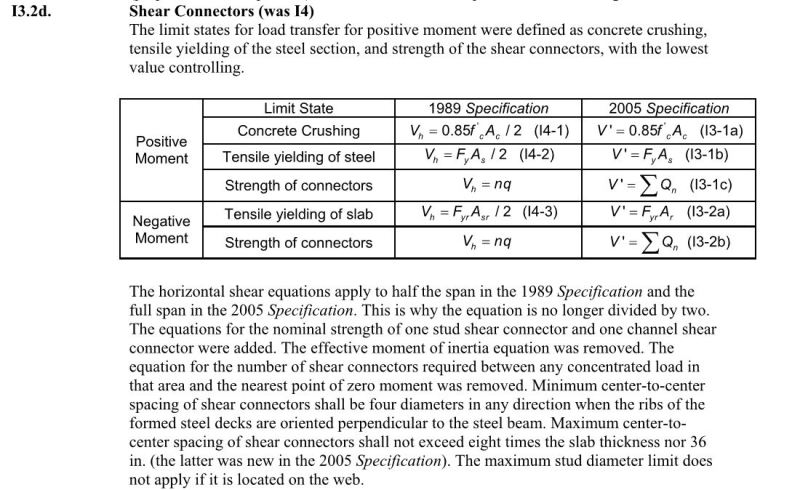Guastavino
Structural
- Jan 29, 2014
- 381
Friends,
So in trying to analyze an existing composite beam I went back through the motions of the AISC 6th edition (ASD of course) and I noticed the divide by 2 in formulas 18 and 19 of chapter "I" regarding shear connectors (They are the 0.85f'c*Ac/2 and As*Fy/2 for those that don't have an old copy handy). Meanwhile, the new 2005 and beyond specs got rid of the divide by 2 which makes sense. However, the "technical reason" per the AISC document "COMPARISON OF ANSI/AISC 360-06 to 1989 ASC Specification" (except below) says that the reason they took it away is because the 1989 and prior equations applied to half the span and the 2005 and beyond apply to the full span, to which I humbly say POPPYCOCK! It's clear as day (to this humble but accurate member) in I3-1c of the 2005 spec that it's related to the max positive moment point to the point of zero moment.
I'm ready to eat crow if I'm wrong, but I'm thinking the old spec and new spec are literally a factor of 2 off, albeit it seems as though the allowable loads for connectors are now higher, so maybe just the explanation by AISC is indeed what is wrong.
Thoughts, comments, anything structurally heretical in my argument? I'm not trying to just "be right", I'm just genuinely confused as to the real reason behind getting rid of the factor of 2. There is an old thread on here about this, but it didn't seem to answer the question for me.

So in trying to analyze an existing composite beam I went back through the motions of the AISC 6th edition (ASD of course) and I noticed the divide by 2 in formulas 18 and 19 of chapter "I" regarding shear connectors (They are the 0.85f'c*Ac/2 and As*Fy/2 for those that don't have an old copy handy). Meanwhile, the new 2005 and beyond specs got rid of the divide by 2 which makes sense. However, the "technical reason" per the AISC document "COMPARISON OF ANSI/AISC 360-06 to 1989 ASC Specification" (except below) says that the reason they took it away is because the 1989 and prior equations applied to half the span and the 2005 and beyond apply to the full span, to which I humbly say POPPYCOCK! It's clear as day (to this humble but accurate member) in I3-1c of the 2005 spec that it's related to the max positive moment point to the point of zero moment.
I'm ready to eat crow if I'm wrong, but I'm thinking the old spec and new spec are literally a factor of 2 off, albeit it seems as though the allowable loads for connectors are now higher, so maybe just the explanation by AISC is indeed what is wrong.
Thoughts, comments, anything structurally heretical in my argument? I'm not trying to just "be right", I'm just genuinely confused as to the real reason behind getting rid of the factor of 2. There is an old thread on here about this, but it didn't seem to answer the question for me.

